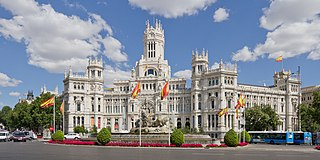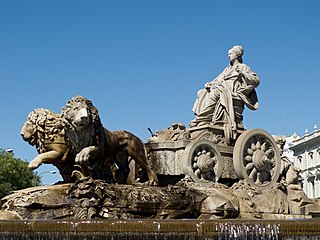
Insurgentes is a station on the Line 1 of Mexico City Metro. It is located within the Glorieta de los Insurgentes at the intersection of Avenida de los Insurgentes and Avenida Chapultepec in Mexico City's Cuauhtémoc borough, close to the Zona Rosa shopping and entertainment district and the Colonia Roma, two of the most iconic neighborhoods in the city. In 2019, the station had an average ridership of 65,134 passengers per day, making it the 12th busiest station in the network. Since 9 November 2023, the station has remained closed for modernization work on the tunnel and the line's technical equipment.

The Paseo del Prado is one of the main boulevards in Madrid, Spain. It runs north–south between the Plaza de Cibeles and the Plaza del Emperador Carlos V, with the Plaza de Cánovas del Castillo lying approximately in the middle. The Paseo del Prado forms the southern end of the city's central axis. It enjoys the status of Bien de Interés Cultural (BIC), and as part of a combined UNESCO World Heritage Site with Buen Retiro Park.

The Plaza de Cibeles is a square with a neo-classical complex of marble sculptures with fountains that has become a symbol for the city of Madrid. It sits at the intersection of Calle de Alcalá, Paseo de Recoletos and Paseo del Prado. Plaza de Cibeles was originally named Plaza de Madrid, but in 1900, the City Council named it Plaza de Castelar, which was eventually replaced by its current name.

Colonia Roma, also called La Roma or simply, Roma, is a district located in the Cuauhtémoc borough of Mexico City just west of the city's historic center. The area comprises two colonias: Roma Norte and Roma Sur, divided by Coahuila street.

Sears Operadora México, S.A. de C.V. is a department store chain located in Mexico, operating 92 stores all over Mexico as of 2022. Sears México is operated by Grupo Sanborns, a division of Grupo Carso.

San Juan Bautista Tuxtepec, or simply referred to as Tuxtepec, is the head of the municipality by the same name and is the second most populous city of the Mexican state of Oaxaca. It is part of the Tuxtepec District of the Papaloapan Region. As of the 2020 census, the city is home to a population of 103,609 and 159,452 in the municipality, though census data are often under reported for various reasons.

Pinotepa Nacional is a city and seat of the municipality of the same name, in the Mexican state of Oaxaca. It is located in the Jamiltepec District in the west of the Costa Region. The name Pinotepa means "toward the crumbling hill" in Náhuatl.
Cybele is an ancient goddess of fertility. Cybele may also refer to:

Tlaxcoaque is a plaza located in the historic center of Mexico City which has given its name to both the 17th-century church that is on it and the blocks that surround it. Historically this plaza and the church that sits on it have marked the southern edge of Mexico City, and today it is on the border of the historic center and Colonia Obrera. The church and plaza are somewhat isolated from the rest of the center due to the construction of wide streets, such as 20 de Noviembre and Fray Servando Teresa de Mier, that separate them from the surrounding buildings. Another notable building in this area is the police surveillance station, which was infamous in the 1970s as a place where detainees were tortured. This stopped after the 1985 Mexico City earthquake exposed handcuffed bodies which had evidence of torture on them. Today, the area around this plaza is semi-deserted outside of work hours and is considered to be a high-crime area. The church itself has experienced break-ins.

Condesa or La Condesa is an area in the Cuauhtémoc Borough of Mexico City, south of Zona Rosa and 4 to 5 km west of the Zócalo, the city's main square. It is immediately west of Colonia Roma, together with which it is designated as a "Barrio Mágico Turístico". Together they are often referred to as Condesa–Roma, one of the most architecturally significant and bastion of the creative communities of the city.

Cibeles Palace, formally known as Palacio de Comunicaciones and Palacio de Telecomunicaciones until 2011, is a complex composed of two buildings with white facades and is located in one of the historical centres of Madrid, Spain. Formerly the city's main post office and telegraph and telephone headquarters, it is now occupied by City Council of Madrid, serving as the city hall, and the public cultural centre CentroCentro.

La Romita is a small neighborhood located in the Colonia Roma section of Mexico City. The area began as an independent pre Hispanic village called Aztacalco, later renamed Romita. When the area around the village was redeveloped into housing for the wealthy, the village resisted and remained separate socially although officially part of Colonia Roma. During the 20th century the area had a reputation for being dangerous as it residents were relatively poor. Today, the area is no longer poor or dangerous, but its streets are narrower than the rest of Colonia Roma and its residents still consider themselves distinct.

The Huntress Diana Fountain stands as a monumental sculptural landmark situated within the roundabout at the intersection of Paseo de la Reforma and Río Misisipí and Sevilla streets. Positioned on the border of the Colonia Cuauhtémoc and Colonia Juárez neighborhoods in Mexico City, this fountain serves as a focal point within the urban fabric of the metropolis. Designed by the Italian architect and sculptor Enrique Alciati, the fountain was unveiled in 1942 and has since become an enduring symbol of Mexico City's cultural heritage and urban landscape. The centerpiece of the fountain is a striking bronze statue depicting Diana, the Roman goddess of the hunt, poised atop a stone pedestal adorned with decorative reliefs and motifs. Adjacent to the Huntress Diana Fountain, several landmarks bear homage to its iconic presence within Mexico City's urban landscape. Among these notable sites are the Cine Diana and two prominent skyscrapers: the Corporativo Reforma Diana and Torre Diana.

The architecture of Madrid has preserved the look and feel of many of its historic neighbourhoods and streets, even though Madrid possesses a modern infrastructure. Its landmarks include the Royal Palace of Madrid, the Royal Theatre with its restored 1850 Opera House, the Buen Retiro Park, the 19th-century National Library building containing some of Spain's historical archives, a large number of national museums, and the Golden Triangle of Art located along the Paseo del Prado and comprising three art museums: Prado Museum, the Reina Sofía Museum, and the Thyssen-Bornemisza Museum, which completes the shortcomings of the other two museums. Cibeles Palace and Fountain have become the monument symbol of the city.

This article covers the history of the Colonia Roma neighborhood of Mexico City.

Plaza Villa de Madrid is a traffic circle in Colonia Roma, Mexico City, where Oaxaca, Durango, Medellín and El Oro streets converge. The Fuente de Cibeles is installed in the center.

Glorieta de Insurgentes is a large roundabout in Mexico City formed at the intersection of Avenida Chapultepec and Avenida de los Insurgentes. Oaxaca Avenue connects to it heading southwest to Fuente de Cibeles. The smaller street Génova connects to Zona Rosa. Jalapa connects via one-way traffic from Colonia Roma.

The Fountain of Cybele is a neoclassical fountain in Madrid, Spain. It lies on the centre of the Plaza de Cibeles. The sculptural group in its centre represents Cybele, a Phrygian earth and fertility deity. It has become one of the icons of the city.

The Fuente de la República is a carbon steel fountain and sculpture installed in Mexico City, Mexico. It was inaugurated on 13 December 2007 by Marcelo Ebrard, the Federal District's head of government, and was placed at the intersection of Avenida Paseo de la Reforma, Avenida Juárez and Avenida Bucareli, in the Cuauhtémoc borough. The fountain was created specifically for the celebrations of the 200th anniversary of the country's independence in 2010. It was designed by Manuel Felguérez, who also designed the Puerta 1808 sculpture found in front of it.




















